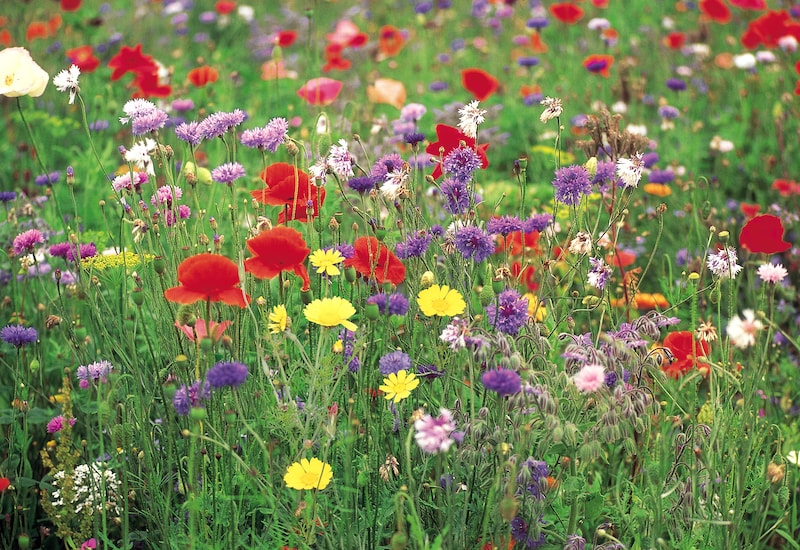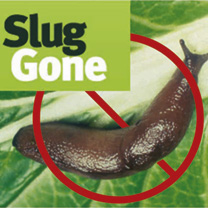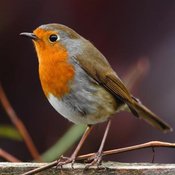Wildflowers provide vital support for a whole range of pollinators, as well as bringing a magical dimension to any garden. Whether you want a fast-growing, brightly-coloured patch of annual wildflowers, or prefer perennial wildflowers that return year after year, you’re in the right place.
Here are some of the best articles, YouTube videos and Instagram posts to help you sow and grow native British wildflower seeds.
Contents:
- The difference between annual and perennial wildflowers
- How and where to sow wildflower seeds
- How to care for wildflowers
The difference between annual and perennial wildflowers
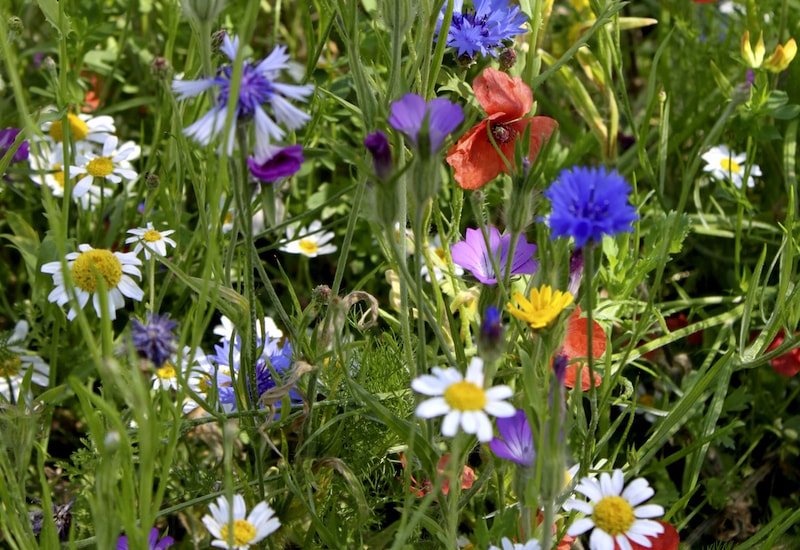
Image: Colourful Annuals Mix Seeds from Suttons
Lee from Garden Ninja explains that there are two main types of wildflower: annual and perennial. But, he says, “if you’ve been led to believe all you need to do is scatter a wildflower seed mix down on the lawn or some open ground then sit back with the Chablis, you’re sadly wrong!” The soil in annual wildflower meadows has to be really well-prepared before sowing and, if your soil is too fertile, or there’s any grass or weeds present, the wildflowers won’t succeed.
Annual wildflowers are showy and colourful, but if you want something longer-lasting that forms a permanent root mat, perennial wildflowers “keep coming back,” says Lauren Lochrie in her fantastic guest post for Gartur Stitch Farm. Alternatively, look for a wildflower mix that combines annual, biennial and perennial seeds. “After two years you can leave the perennials to develop, or re-sow.” Read her full article: Wild about wildflowers, for more tips.
How and where to sow wildflower seeds
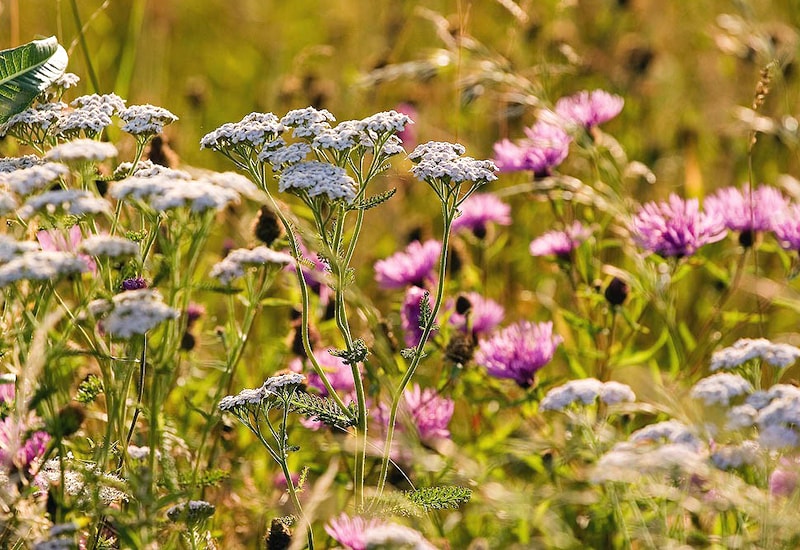
Image: Fragrant Flowers Mix Seeds from Suttons
When it comes to sowing wildflower seeds, the team at Oxford Urban Wildlife Group recommend a sunny, open spot. In their step-by-step guide to sowing a perennial wildflower meadow, they explain that you’ll probably have to remove the top layer of topsoil to reduce its fertility. That’s because “highly fertile soil encourages excess vigour in grasses causing them to crowd out wildflowers.” Once the ground is prepared, they recommend using about 5 grams of seed per square metre.
When Matt from Grow Like Grandad terraced his garden, he was left with an area of very poor quality soil that he couldn’t afford to remedy straight away. But turning this to his advantage, it did allow him to experiment with a mixed perennial and wildflower planting scheme. “Essentially, this involves planting perennials into a wildflower area in a random naturalistic way prior to sowing the wildflower seed around them,” explains Matt. His top tip? Plant the perennials into informal groups of compost-filled holes (because they need the nutrition) and then scatter the wildflower seeds everywhere else.
In another hybrid scheme, Lou from@louswildgarden replaced her entire front lawn with a combination of wildflowers and cottage garden favourites. She used a pollinator-friendly seed mix alongside wildflower plugs to help it get established quickly. Her aim, she explains, is “to provide some nectar through the year, habitat coverage, cheering colour and…more caterpillar food for the few remaining butterflies we have left floating around.” Visit her post to see the inspirational images and a planting list.
If, like Tom at Tec Mow, you want to turn your lawn into a wildflower meadow, you should do it in September. That’s because you’ll need lots of Yellow Rattle to keep the other grasses down, and these seeds need a period of intense cold to germinate. Tom’s fantastic 4-part video series follows his entire wildflower journey, sharing all of the ups and downs, successes and failures. There’s no need to learn the hard way when lovely gardeners like Tom are so generous with their tried-and-tested knowledge.
How to care for wildflowers
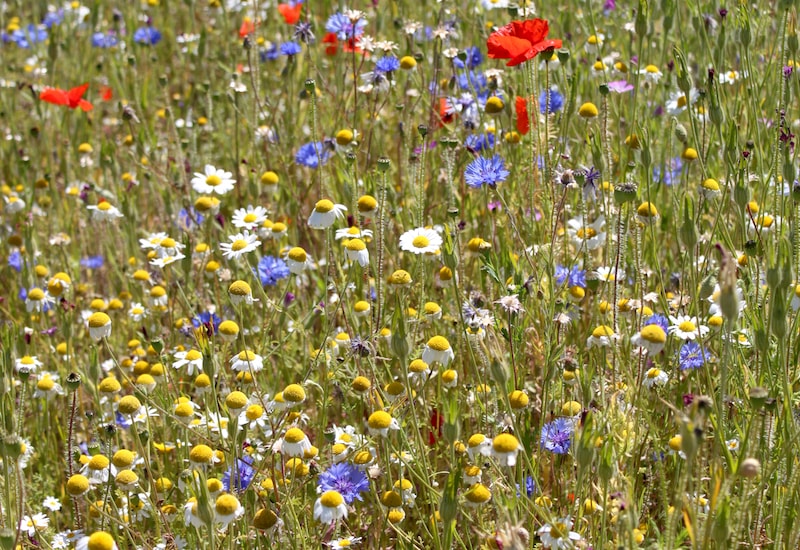
Image: Cornfield Annuals Mix Seeds from Suttons/©Branded Garden Products
Wildflowers do require a little maintenance to help them produce the best display, explains Terka from @terkaactongardendesign. If your wildflowers begin to look a bit leggy towards the end of June, she recommends a high cut to “prevent areas of meadow keeling over, and allow the plants to rebloom.” Take a look at her mown meander path too – it’s a great way to protect your wildflowers while providing access to the rest of the garden.
Wildflower meadows do require some maintenance, says the team at Groundwork. “Once the plants have concluded flowering, normally towards the end of the season in September and October, keep on top of your area by going over it with a strimmer,” they explain. Their top tip? If your wildflowers are annuals, be sure they’ve produced and dropped seeds before you cut them back. That way you’ll get more blooms the following year.
Over at @tom_dibb_pumpkindredspirits, Tom cuts his wildflower border back in October, carefully removing all the cuttings so that they can’t fertilise the soil. Although it looks a little sparse, not feeding the soil means that grass is less likely to flourish and take over. A keen wildlife lover, Tom piles the cuttings up nearby, “for overwintering insects”.
We hope this has given you plenty of tips to help you grow wildflowers. Even if you don’t have much space, you can grow them in containers or window boxes. Looking for more wildlife-friendly ideas? Read our article on how to make space for nature in your garden.
Lead image: Wildflower Seeds – Collection from Suttons
Last Updated on September 13, 2024 by Suttons Horticultural Team

